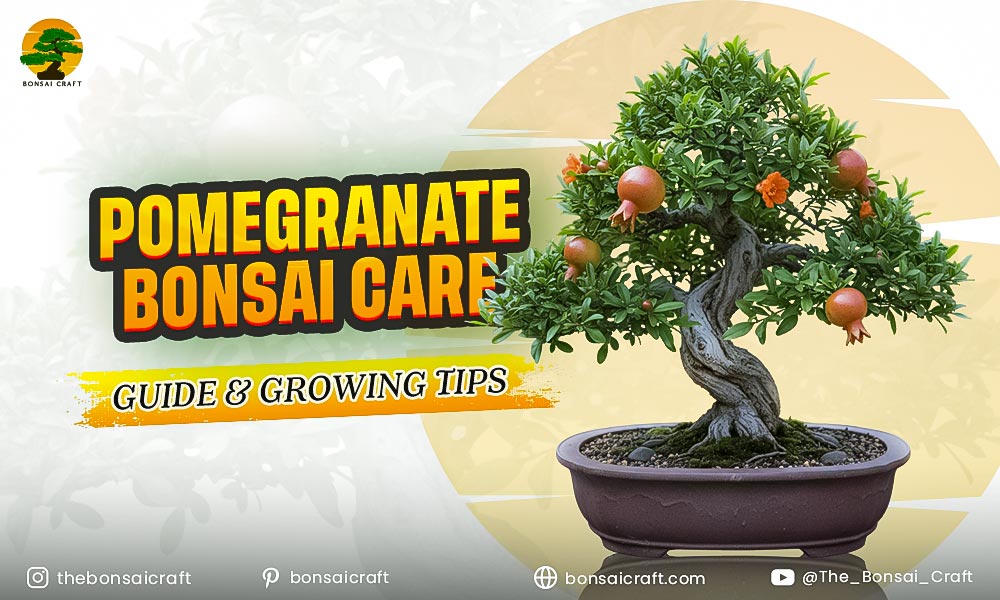
The pomegranate bonsai is one of the most admired fruiting bonsai trees, combining vibrant blossoms, glossy green leaves, and miniature pomegranates that symbolize prosperity and abundance. Unlike many other bonsai species, this tree offers the joy of both ornamental beauty and edible fruits. Whether you’re a beginner experimenting with a mini pomegranate tree or an experienced grower shaping a dwarf pomegranate bonsai, this species is rewarding for its resilience, unique styling opportunities, and seasonal appeal.
Drawing from years of horticultural expertise and trusted bonsai resources, this guide will walk you through everything you need to know about pomegranate bonsai care—from soil, pruning, and watering, to styling techniques, indoor vs. outdoor growing, and even fruit production.
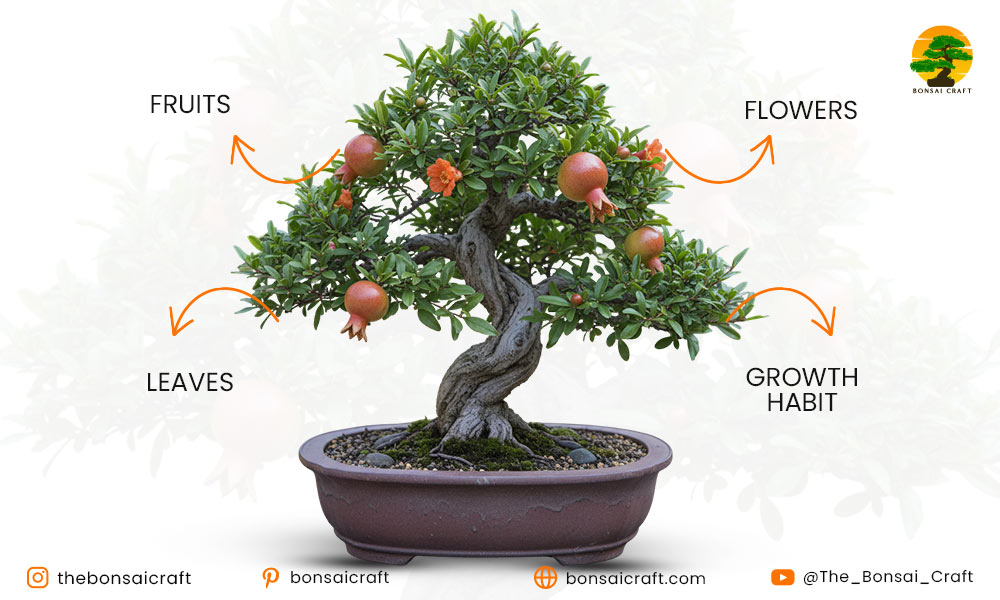
The Beauty of the Pomegranate Bonsai
The bonsai pomegranate tree belongs to the genus Punica, with the Punica granatum (common pomegranate) and Punica granatum var. nana (dwarf pomegranate bonsai) being the most popular for bonsai cultivation. The dwarf variety is especially suited for small containers because of its compact size, small leaves, and miniature fruit.
- Flowers: Funnel-shaped, fiery red to orange blooms
- Leaves: Glossy, lance-shaped, and deciduous in cold climates
- Fruits: Small, round, and often edible, though miniatures are best admired as ornamentals
- Growth habit: Adaptable to different bonsai styles, particularly informal upright, broom, and cascade
Its blend of fruit, flower, and foliage makes it one of the most complete bonsai experiences.
Pomegranate Bonsai Care Basics
Growing a bonsai pomegranate is relatively straightforward, provided you understand its needs. Below are the essential care guidelines.
Light Requirements
Does a pomegranate bonsai need full sun?
Yes, a pomegranate bonsai plant thrives best in full sun exposure for at least 6–8 hours daily. Adequate sunlight ensures strong growth, vibrant blooms, and fruit development. Indoors, supplement with strong grow lights if sunlight is insufficient.
Watering Schedule
- Water thoroughly when the top 1–2 inches of soil feels dry.
- Avoid waterlogging, which can cause root rot.
- In summer, daily watering may be necessary, while in winter, reduce frequency.
- Mist occasionally to maintain humidity, especially for indoor bonsai pomegranate.
Soil Requirements
The best soil for pomegranate bonsai care is a well-draining bonsai mix containing akadama, pumice, and lava rock. Adding organic matter improves nutrient retention.
Temperature & Climate
- Ideal range: 65–85°F (18–29°C)
- Can tolerate short periods of cold, but prolonged frost harms roots
- For pomegranate bonsai indoor or outdoor, outdoor growing is better, but in cold zones, bring indoors during winter
How to Grow a Pomegranate Bonsai from Seed
Can you grow a pomegranate bonsai tree from seed?
Yes! Growing a bonsai pomegranate from seed is a rewarding long-term project, though it requires patience.
Steps:
- Collect seeds from fresh fruit. Wash and dry thoroughly.
- Stratify (optional in warm climates, but improves germination in temperate zones).
- Plant seeds in spring in a well-draining bonsai soil mix.
- Water lightly and cover with plastic wrap for humidity.
- Germination takes 1–6 weeks.
- Transplant seedlings into bonsai pots once 4–6 inches tall.
- Begin training your pomegranate bonsai tree within 2–3 years.
For quicker results, many enthusiasts prefer nursery-grown saplings.
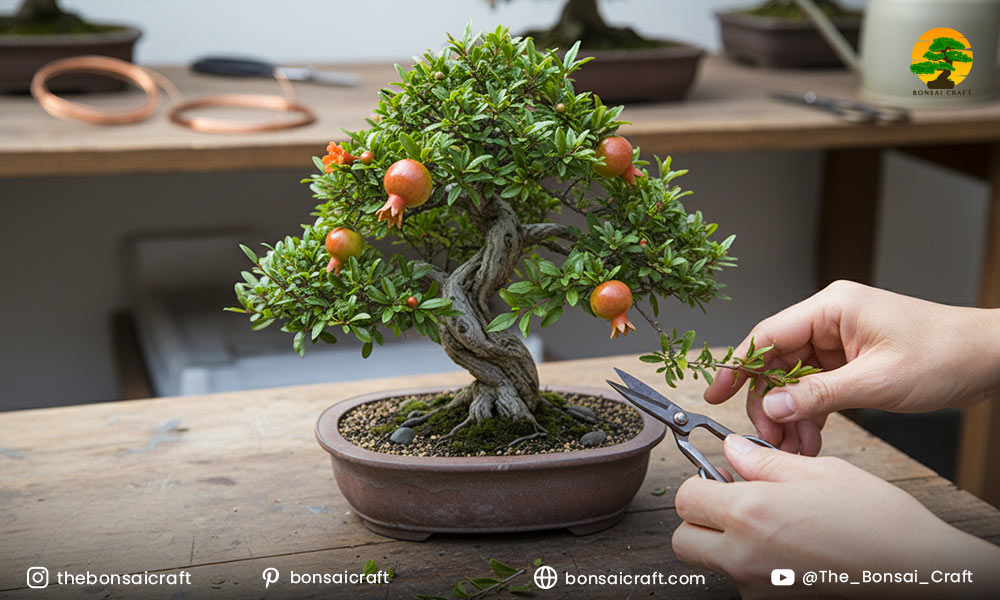
Pruning Pomegranate Bonsai
When to prune pomegranate bonsai?
Prune in late winter or early spring before new growth starts. This timing reduces stress and promotes healthy new shoots.
Techniques:
- Maintenance pruning: Pinch back shoots after 4–6 leaves to maintain shape.
- Structural pruning: Remove thicker branches during dormancy to define style.
- Defoliation (advanced): Encourages smaller leaves in mature trees.
⚠️ Avoid heavy pruning into old wood, as new buds may not sprout.
Wiring and Styling Bonsai Pomegranate Trees
The bonsai pomegranate is flexible, making it easy to style.
- Wire branches in late spring when supple.
- Use aluminum wire to avoid damaging bark.
- Popular styles:
- Informal upright
- Multi-trunk
- Broom style
- Cascade bougainvillea-style bonsai with fruit hanging naturally
Because of its fruiting habit, styles that showcase branches with fruits are most attractive.
Repotting Pomegranate Bonsai
When to repot pomegranate bonsai?
Every 2–3 years in early spring before buds swell.
Steps:
- Gently remove tree from the pot.
- Trim about one-third of the root mass.
- Refresh with a new bonsai soil mix.
- Place in shade for a week before returning to full sun.
Repotting maintains root health and prevents soil compaction.
Fertilizing Pomegranate Bonsai
To encourage flowers and fruits:
- Use balanced bonsai fertilizer (10-10-10) during spring and summer.
- Switch to low nitrogen fertilizer during flowering to promote fruiting.
- Fertilize every 2 weeks in the growing season, once a month in fall.
- Stop fertilizing in winter dormancy.
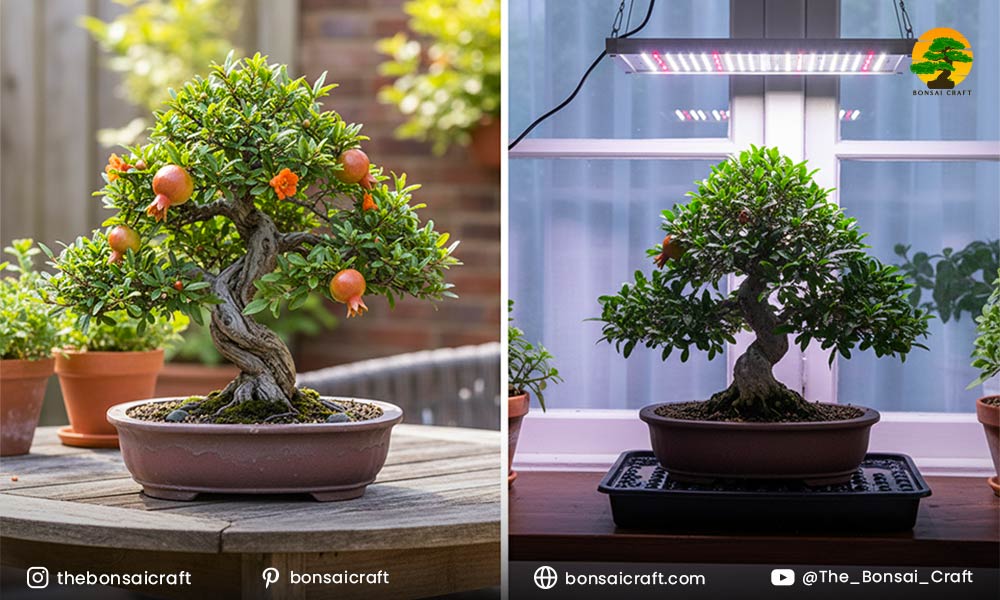
Pomegranate Bonsai Indoor vs. Outdoor Growing
- Outdoor: Best for strong growth, natural light, and fruiting
- Indoor: Possible if provided with strong light, humidity trays, and regular care
If you choose a pomegranate bonsai indoor, place it near south-facing windows or use LED grow lights.
Pomegranate Bonsai Winter Care
How to protect in winter:
- In mild zones, the Tree may tolerate outdoor dormancy.
- In cold zones: Bring indoors before frost.
- Store in a cool room (40–55°F) to allow light dormancy.
- Water sparingly, just enough to prevent soil from drying out completely.
Fruit Production in Pomegranate Bonsai
Yes, pomegranate bonsai fruit is possible!
- Dwarf pomegranate bonsai often bear small, ornamental fruits.
- Regular bonsai pomegranate trees can produce edible fruits, though smaller than full-sized trees.
- For best results:
- Ensure strong sunlight
- Prune selectively, not excessively
- Fertilize properly
- Hand-pollinate indoor trees
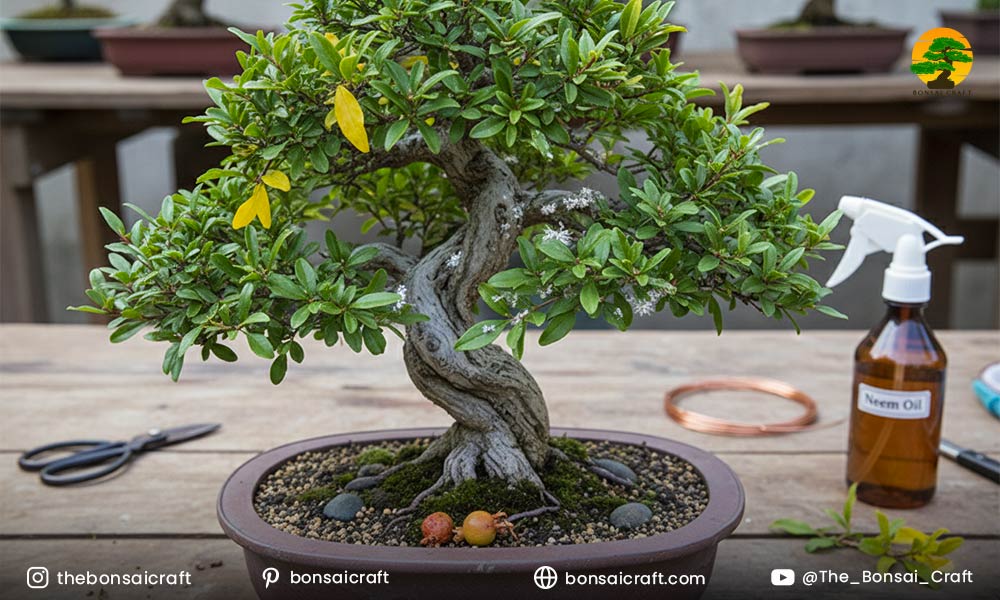
Common Problems in Pomegranate Bonsai Care
- Pests: Aphids, whiteflies, spider mites—control with neem oil or insecticidal soap.
- Diseases: Root rot (from overwatering), powdery mildew in humid climates.
- Leaf issues: Yellowing (nutrient deficiency or overwatering).
- Fruit drop: Often caused by lack of sunlight or irregular watering.
Conclusion
The pomegranate bonsai tree is a symbol of beauty, abundance, and resilience, offering bonsai lovers a rewarding experience that includes stunning flowers and miniature fruits. With proper pruning, repotting, watering, and seasonal care, you can enjoy a thriving bonsai pomegranate for decades.
Whether you choose a dwarf pomegranate bonsai for its compact elegance or a larger bonsai pomegranate tree for edible fruit, this species stands as one of the most fulfilling bonsai projects.
💡 Expert Tip: Always observe your tree’s growth cycle. Adjust watering, pruning, and fertilization based on its natural rhythm for healthier growth and better fruiting.
FAQs About Pomegranate Bonsai Care
Can you bonsai a pomegranate tree?
Yes. The pomegranate tree bonsai adapts well to pruning and training, making it an excellent bonsai species. Its small leaves, showy flowers, and fruits add unique charm.
How to grow a pomegranate bonsai from seed?
Plant cleaned seeds in spring in bonsai soil. Keep moist, provide sunlight, and expect germination within weeks. Shape your mini pomegranate tree after 2–3 years.
Can pomegranate bonsai bear fruit?
Yes! Both dwarf pomegranate bonsai and regular varieties produce fruit. While dwarf fruits are ornamental, standard types can yield edible mini fruits.
Is pomegranate bonsai indoor or outdoor?
Outdoors is best, but pomegranate bonsai indoor growing works with sufficient sunlight or grow lights, proper humidity, and regular care.
How often should I repot a pomegranate bonsai?
Every 2–3 years in early spring. Trim roots moderately, refresh soil, and place the bonsai in shade for recovery before moving back to sunlight.
